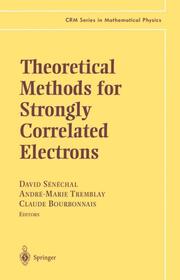-
Zusatztext
-
Focusing on the purely theoretical aspects of strongly correlated electrons, this volume brings together a variety of approaches to models of the Hubbard type - i.e., problems where both localized and delocalized elements are present in low dimensions. The chapters are arranged in three parts. The first part deals with two of the most widely used numerical methods in strongly correlated electrons, the density matrix renormalization group and the quantum Monte Carlo method. The second part covers Lagrangian, Functional Integral, Renormalization Group, Conformal, and Bosonization methods that can be applied to one-dimensional or weakly coupled chains. The third part considers functional derivatives, mean-field, self-consistent methods, slave-bosons, and extensions.
-
-
Kurztext
-
Includes supplementary material: sn.pub/extras
-
-
Autorenportrait
- InhaltsangabeContents Series Preface Preface C. Bourbonnais, D. Senechal, A. Ruckenstein, and A.-M.S. Tremblay I Numerical Methods 1 Density Matrix Renormalization Karen Hallberg 1 Introduction 2 The Method 3 Applications 4 Other Extensions to DMRG 4.1 Classical Systems 4.2 FiniteTemperature DMRG 4.3 Phonons, Bosons and Disorder 4.4 Molecules and Quantum Chemistry 5 Dynamical Correlation Functions 5.1 Lanczos and Correction Vector Techniques 5.2 Moment Expansion 5.3 Finite Temperature Dynamics 6 Conclusions 7 References 2 Quantum Monte Carlo Methods for Strongly Correlated Electron Systems Shiwei Zhang 1 Introduction 2 Preliminaries 2.1 Starting Point of Quantum Monte Carlo (QMC) 2.2 Basics of Monte Carlo Techniques 2.3 Slater Determinant Space 2.4 HubbardStratonovich Transformation 3 Standard AuxiliaryField Quantum Monte Carlo 3.1 GroundState Method 3.2 FiniteTemperature Method 4 Constrained Path Monte Carlo MethodsGroundState and FiniteTemperature 4.1 Why and How Does the Sign Problem Occur? 4.2 The Constrained-Path Approximation 4.3 GroundState Constrained Path Monte Carlo (CPMC) Method 4.4 FiniteTemperature Method 4.5 Additional Technical Issues 5 Illustrative Results 6 Summary 7 References A Brief Review of Con.guration-Space Methods A.1 Variational Monte Carlo A.2 Green's Function Monte Carlo (GFMC) II Lagrangian, Functional Integral, Renormalization Group, Conformal and Bosonization Methods Renormalization Group Technique for Quasi-One-Dimensional Interacting Fermion Systems at Finite Temperature C. Bourbonnais, B. Guay and R. Wortis 1 Introduction 2 Scaling Ansatz for Fermions 2.1 One Dimension 2.2 Anisotropic Scaling and Crossover Phenomena 3 Free Fermion Limit 3.1 One Dimension 3.2 Interchain Coupling 4 The Kadano.-Wilson Renormalization Group 4.1 OneDimensional Case 4.2 OneLoop Results 4.3 TwoLoop Results 4.4 Response Functions 5 Interchain Coupling: One-Particle Hopping 5.1 Interchain Pair Hopping and Long-Range Order 5.2 LongRange Order in the Decon.ned Region 6 KohnLuttinger Mechanism in QuasiOneDimensional Metals 6.1 Generation of Interchain Pairing Channels 6.2 Possibility of Long-Range Order in the Interchain Pairing Channels 7 Summary and Concluding Remarks 8 References A One-Particle Self-Energy at the Two-Loop Level A.1 Backward and Forward Scattering Contributions A.2 Umklapp contribution 4 An Introduction to Bosonization D. Senechal 1 Quantum Field Theory in Condensed Matter 2 A Word on Conformal Symmetry 2.1 Scale and Conformal Invariance 2.2 Conformal Transformations 2.3 E.ect of Perturbations 2.4 The Central Charge 3 Interacting Electrons in One Dimension 3.1 Continuum Fields and Densities 3.2 Interactions 4 Bosonization: A Heuristic View 4.1 Why Is One-Dimension Special? 4.2 The Simple Boson 4.3 Bose Representation of the Fermion Field 5 Details of the Bosonization Procedure 5.1 Left and Right Boson Modes 5.2 Proof of the Bosonization Formulas: Vertex Operators 5.3 Bosonization of the Free-Electron Hamiltonian 5.4 Spectral Equivalence of Boson and Fermion 5.5 Case of Many Fermion Species: Klein Factors 5.6 Bosonization of Interactions 6 Exact Solution of the Tomonaga-Luttinger Model 6.1 Field and Velocity Renormalization 6.2 LeftRight Mixing 6.3 Correlation Functions 6.4 Spin or Charge Gap 7 Non-Abelian Bosonization 7.1 Symmetry Currents 7.2 Application to the Perturbed Tomonaga-Luttinger Model 8 Other Applications of Bosonization 8.1 The Spin 12 Heisenberg Chain 8.2 Edge States in Quantum Hall Systems 8.3 And More
Detailansicht
Theoretical Methods for Strongly Correlated Electrons
CRM Series in Mathematical Physics
ISBN/EAN: 9781475780598
Umbreit-Nr.: 5649721
Sprache:
Englisch
Umfang: xviii, 362 S.
Format in cm:
Einband:
kartoniertes Buch
Erschienen am 21.04.2013
Auflage: 1/2004


